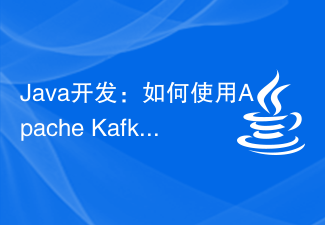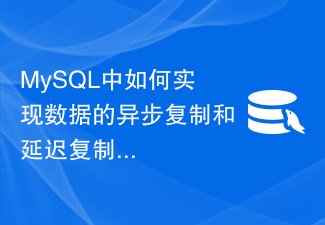Oracle GoldenGate enables real-time data replication and integration by capturing the transaction logs of the source database and applying changes to the target database. 1) Capture changes: Read the transaction log of the source database and convert it to a Trail file. 2) Transmission changes: Transmission to the target system over the network, and transmission is managed using a data pump process. 3) Application changes: On the target system, the copy process reads the Trail file and applies changes to ensure data consistency.
introduction
In a modern data-driven world, real-time data replication and integration are becoming increasingly important. Oracle GoldenGate, as a powerful data integration and replication tool, can help us achieve this? This article will take you into the deeper understanding of Oracle GoldenGate, explore its real-time data replication and integration capabilities, and how to maximize its effectiveness in practical applications. By reading this article, you will learn how to use Oracle GoldenGate for efficient data replication and integration, and improve your data management capabilities.
Review of basic knowledge
Oracle GoldenGate is a software for real-time data replication and integration. It can help you synchronize data between different databases, whether it is Oracle database, or other such as MySQL, SQL Server, etc. Its core function is to capture changes to the source database and apply these changes to the target database, thereby enabling real-time synchronization of data.
Before using Oracle GoldenGate, you need to understand some basic concepts, such as transaction logs, replication topology, data pumps, etc. These concepts are the basis for understanding and configuring Oracle GoldenGate.
Core concept or function analysis
The definition and function of Oracle GoldenGate
The core function of Oracle GoldenGate is real-time data replication. It enables real-time synchronization of data by capturing the transaction log of the source database, extracting change data, and applying these changes to the target database. This mechanism can not only be used for disaster recovery, but also for various scenarios such as data integration, reporting, and data warehouse.
For example, here is a simple Oracle GoldenGate configuration example:
-- Configure the extract process EXTRACT ext1 on the source database USERIDALIAS gg_user DOMAIN OracleGoldenGate EXTTRAIL ./dirdat/aa TABLE hr.employees; -- Configure the replication process REPLICAT rep1 on the target database USERIDALIAS gg_user DOMAIN OracleGoldenGate ASSUMETARGETDEFS MAP hr.employees, TARGET hr.employees;
This example shows how to configure a simple fetch and replication process to copy data from the hr.employees table from the source database to the target database.
How it works
The working principle of Oracle GoldenGate can be divided into the following steps:
Capture changes : Oracle GoldenGate captures data changes by reading the transaction log of the source database (such as Oracle's Redo Log). These changes are converted into Oracle GoldenGate's internal format, called Trail files.
Transmission Change : Change data is transmitted to the target system over the network. Oracle GoldenGate uses data pump processes to manage this process to ensure reliable data transmission.
Apply changes : On the target system, the copy process of Oracle GoldenGate reads the Trail file and applies the changes to the target database to ensure data consistency.
This mechanism is not only efficient, but also has minimal impact on the performance of the source database. Oracle GoldenGate also supports a variety of replication topology, such as one-way replication, two-way replication, multi-point replication, etc., to meet different business needs.
Example of usage
Basic usage
Let's look at a basic Oracle GoldenGate configuration for copying a table's data from an Oracle database to a MySQL database:
-- Configure the extract process EXTRACT ext1 on the Oracle database USERIDALIAS gg_user DOMAIN OracleGoldenGate EXTTRAIL ./dirdat/aa TABLE hr.employees; -- Configure the replication process REPLICAT rep1 on the MySQL database USERIDALIAS gg_user DOMAIN OracleGoldenGate ASSUMETARGETDEFS MAP hr.employees, TARGET hr.employees;
This configuration copies the data from the hr.employees table from the Oracle database to the MySQL database. The extract process runs on the Oracle database, captures changes and writes to the Trail file; the copy process runs on the MySQL database, reads the Trail file and applies the changes.
Advanced Usage
Oracle GoldenGate also supports some advanced features such as data filtering, transformation and conflict resolution. Here is an example showing how to convert data during replication:
-- Configure the extract process EXTRACT ext1 on the source database
USERIDALIAS gg_user DOMAIN OracleGoldenGate
EXTTRAIL ./dirdat/aa
TABLE hr.employees;
-- Configure the replication process on the target database and perform data conversion REPLICAT rep1
USERIDALIAS gg_user DOMAIN OracleGoldenGate
ASSUMETARGETDEFS
MAP hr.employees, TARGET hr.employees,
COLMAP (USED BY DEFAULT,
salary = salary * 1.1); In this example, we increase the value of salary field by 10% during the copying process. This data conversion function can help you perform business logic processing during data replication.
Common Errors and Debugging Tips
When using Oracle GoldenGate, you may encounter some common problems, such as:
- Data inconsistency : Make sure the table structure of the source and destination databases is consistent and check whether there are any data loss or duplication.
- Performance issues : Optimize the parameters of the extract and replicate processes to ensure that they do not have excessive impact on database performance.
- Network problems : Ensure stable network connection and avoid interruption of data transmission.
When debugging these problems, you can use the logging and reporting tools provided by Oracle GoldenGate to help you quickly locate and resolve problems.
Performance optimization and best practices
In practical applications, how to optimize the performance of Oracle GoldenGate? Here are some suggestions:
- Parameter optimization : Adjust the parameters of the extraction and copying process, such as
CHECKPOINTSECS,MAXTRANSOPS, etc., to optimize performance. - Data compression : Enable data compression function to reduce the amount of data transmitted on the network.
- Parallel processing : Use parallel extraction and copying processes to improve data processing speed.
Here is an optimization example:
-- Optimize extraction process EXTRACT ext1 USERIDALIAS gg_user DOMAIN OracleGoldenGate EXTTRAIL ./dirdat/aa CHECKPOINTSECS 60 MAXTRANSOPS 1000 TABLE hr.employees; -- Optimize the replication process REPLICAT rep1 USERIDALIAS gg_user DOMAIN OracleGoldenGate ASSUMETARGETDEFS CHECKPOINTSECS 60 MAXTRANSOPS 1000 MAP hr.employees, TARGET hr.employees;
In this example, we tuned CHECKPOINTSECS and MAXTRANSOPS parameters to optimize the performance of the extraction and replication process.
There are some best practices to note when using Oracle GoldenGate:
- Code readability : Ensure the configuration file is clear and easy to understand, and use comments to explain the role of each configuration.
- Monitoring and maintenance : Regularly monitor the operating status of Oracle GoldenGate and handle abnormal situations in a timely manner.
- Backup and Restore : Regularly back up Oracle GoldenGate configuration and data to ensure rapid recovery in the event of a failure.
Through these optimizations and best practices, you can fully realize the potential of Oracle GoldenGate to enable efficient real-time data replication and integration.
In-depth insights and suggestions
There are several key points that need special attention when using Oracle GoldenGate:
Data consistency : Oracle GoldenGate captures changes through transaction logs to ensure data consistency. But in some cases, such as network outages or database failures, data inconsistencies can be caused. Therefore, it is recommended to consider the inspection and recovery mechanism of data consistency when configuring Oracle GoldenGate.
Performance Bottlenecks : While Oracle GoldenGate is designed to be very efficient, the extraction and replication processes can become performance bottlenecks under high load conditions. It is recommended that in actual applications, regularly monitor the performance of these processes, adjust parameters in time or increase resources.
Complexity management : Oracle GoldenGate configuration and management are relatively complex, especially in multi-database and multi-topology environments. It is recommended that when implementing Oracle GoldenGate, detailed plans and documentation are formulated to ensure that team members can quickly get started and maintain.
Cost and Benefits : Oracle GoldenGate is a powerful tool, but it also requires a certain cost investment. It is recommended to evaluate whether the benefits it brings are worth these costs before choosing Oracle GoldenGate.
With these in-depth insights and suggestions, you can better understand and use Oracle GoldenGate, avoid common pitfalls and challenges, and enable efficient real-time data replication and integration.
The above is the detailed content of Oracle GoldenGate: Real-Time Data Replication & Integration. For more information, please follow other related articles on the PHP Chinese website!
 Java开发:如何使用Apache Kafka Connect进行数据集成Sep 21, 2023 pm 02:33 PM
Java开发:如何使用Apache Kafka Connect进行数据集成Sep 21, 2023 pm 02:33 PMJava开发:如何使用ApacheKafkaConnect进行数据集成引言:随着大数据和实时数据处理的兴起,数据集成变得越来越重要。在处理数据集成时,一个常见的挑战是将各种数据源和数据目标连接起来。ApacheKafka是一个流行的分布式流处理平台,其中的KafkaConnect是用于数据集成的一个重要组件。本文将详细介绍如何使用Java开发,利用A
 MySQL中的数据集成实践方法Jun 15, 2023 pm 12:11 PM
MySQL中的数据集成实践方法Jun 15, 2023 pm 12:11 PMMySQL是广泛应用于企业或个人开发的关系型数据库管理系统,同时也是非常简单易用、可靠性高的数据库系统。在企业级系统中,MySQL的数据集成实践方法非常重要。在这篇文章中,我们将详细讲解MySQL中的数据集成实践方法。数据集成数据集成是将不同系统中的数据集成到一个系统中的过程。这样做的目的是使数据在相同的数据模型和语义下进行管理和使用。在MySQL中,数据集
 如何在Java中实现分布式系统的数据复制和数据同步Oct 09, 2023 pm 06:37 PM
如何在Java中实现分布式系统的数据复制和数据同步Oct 09, 2023 pm 06:37 PM如何在Java中实现分布式系统的数据复制和数据同步随着分布式系统的兴起,数据复制和数据同步成为保障数据一致性和可靠性的重要手段。在Java中,我们可以利用一些常见的框架和技术来实现分布式系统的数据复制和数据同步。本文将详细介绍如何利用Java实现分布式系统中的数据复制和数据同步,并给出具体的代码示例。一、数据复制数据复制是将数据从一个节点复制到另一个节点的过
 如何使用PHP数据库连接实现数据的同步和复制Sep 08, 2023 pm 02:54 PM
如何使用PHP数据库连接实现数据的同步和复制Sep 08, 2023 pm 02:54 PM如何使用PHP数据库连接实现数据的同步和复制在许多Web应用程序中,数据的同步和复制是非常重要的。例如,当您有多个数据库服务器时,您可能需要确保这些服务器上的数据保持同步,以便用户在访问应用程序时始终获取最新的数据。幸运的是,使用PHP数据库连接,您可以轻松地实现数据的同步和复制。本文将介绍使用PHP数据库连接实现数据同步和复制的步骤,并提供相应的代码示例供
 MySQL中如何实现数据的异步复制和延迟复制?Jul 31, 2023 pm 12:58 PM
MySQL中如何实现数据的异步复制和延迟复制?Jul 31, 2023 pm 12:58 PMMySQL是一种常用的关系型数据库管理系统,在实际应用中,我们经常会遇到需要进行数据复制的场景。数据的复制可以分为同步复制和异步复制两种形式。同步复制是指在主数据库写入数据后必须立即将数据复制到从数据库,而异步复制则是主数据库写入数据后可以延迟一定时间再进行复制。本文将重点介绍MySQL中如何实现数据的异步复制和延迟复制。首先,为了实现异步复制和延迟复制,我
 深入剖析MongoDB的数据复制与故障恢复机制Nov 04, 2023 pm 04:07 PM
深入剖析MongoDB的数据复制与故障恢复机制Nov 04, 2023 pm 04:07 PM深入剖析MongoDB的数据复制与故障恢复机制引言:随着大数据时代的到来,数据的存储和管理变得愈发重要。在数据库领域,MongoDB作为一种广泛应用的NoSQL数据库,其数据复制和故障恢复机制对于保障数据的可靠性和高可用性至关重要。本文将深入剖析MongoDB的数据复制与故障恢复机制,以便读者对该数据库有更深入的了解。一、MongoDB的数据复制机制数据复制
 如何使用MongoDB实现数据的复制和分片功能Sep 20, 2023 pm 12:06 PM
如何使用MongoDB实现数据的复制和分片功能Sep 20, 2023 pm 12:06 PM如何使用MongoDB实现数据的复制和分片功能引言:MongoDB是一个十分流行的NoSQL数据库系统,它具有高性能、可扩展性和可靠性等特点。在大数据时代,数据量的增长是一种常态,因此数据的复制和分片成为了保证数据可靠性和性能的关键功能。本文将详细介绍如何使用MongoDB实现数据的复制和分片,并提供相应的代码示例。一、数据复制数据复制是MongoDB中保
 利用MongoDB技术开发中遇到的数据复制冲突问题的解决方案探究Oct 10, 2023 pm 07:53 PM
利用MongoDB技术开发中遇到的数据复制冲突问题的解决方案探究Oct 10, 2023 pm 07:53 PM利用MongoDB技术开发中遇到的数据复制冲突问题的解决方案探究摘要:在使用MongoDB的开发过程中,可能会遇到数据复制冲突的问题。这种问题在分布式环境中尤其常见,因为在多个节点上同时执行写操作,容易出现冲突和数据不一致的情况。本文将探讨利用MongoDB技术解决数据复制冲突的方案,并提供具体代码示例。一、问题背景在分布式环境下,并行处理多个写操作是很常见


Hot AI Tools

Undresser.AI Undress
AI-powered app for creating realistic nude photos

AI Clothes Remover
Online AI tool for removing clothes from photos.

Undress AI Tool
Undress images for free

Clothoff.io
AI clothes remover

AI Hentai Generator
Generate AI Hentai for free.

Hot Article

Hot Tools

SublimeText3 Mac version
God-level code editing software (SublimeText3)

MantisBT
Mantis is an easy-to-deploy web-based defect tracking tool designed to aid in product defect tracking. It requires PHP, MySQL and a web server. Check out our demo and hosting services.

MinGW - Minimalist GNU for Windows
This project is in the process of being migrated to osdn.net/projects/mingw, you can continue to follow us there. MinGW: A native Windows port of the GNU Compiler Collection (GCC), freely distributable import libraries and header files for building native Windows applications; includes extensions to the MSVC runtime to support C99 functionality. All MinGW software can run on 64-bit Windows platforms.

WebStorm Mac version
Useful JavaScript development tools

Safe Exam Browser
Safe Exam Browser is a secure browser environment for taking online exams securely. This software turns any computer into a secure workstation. It controls access to any utility and prevents students from using unauthorized resources.







